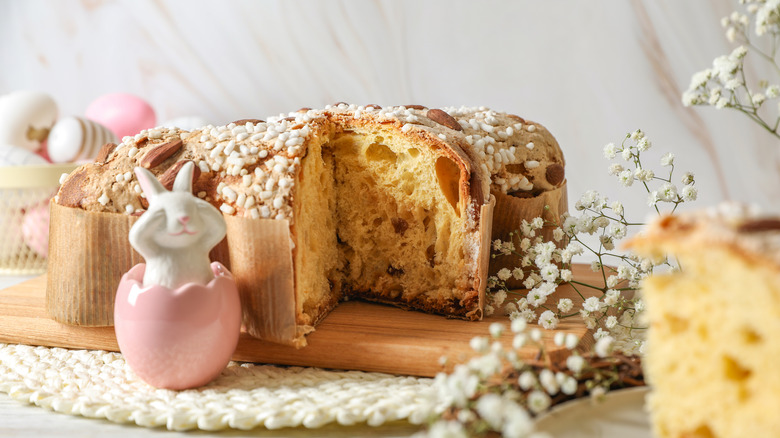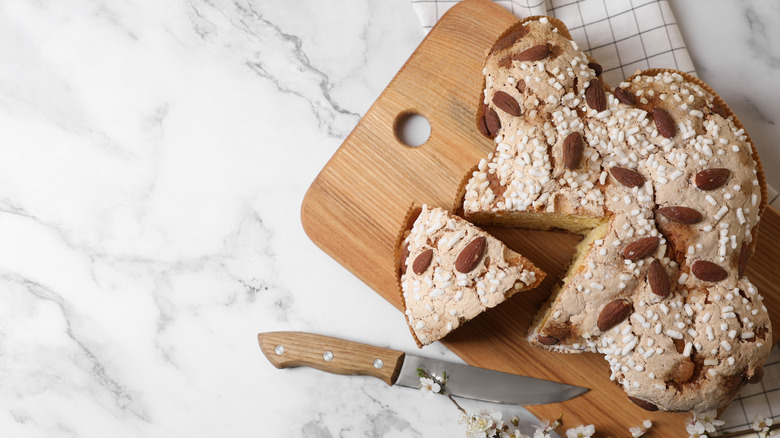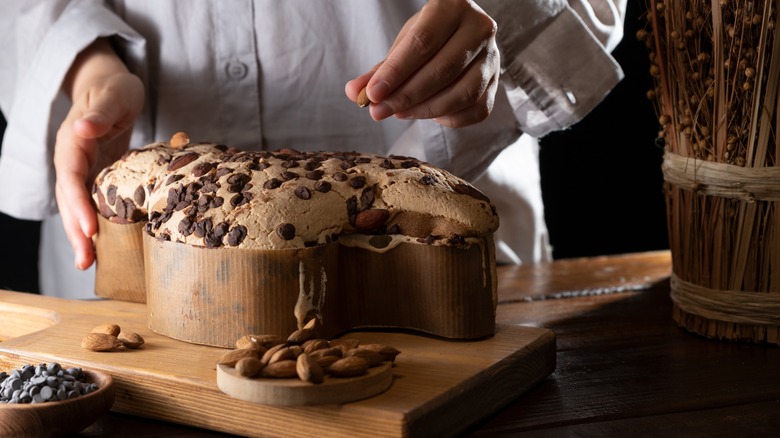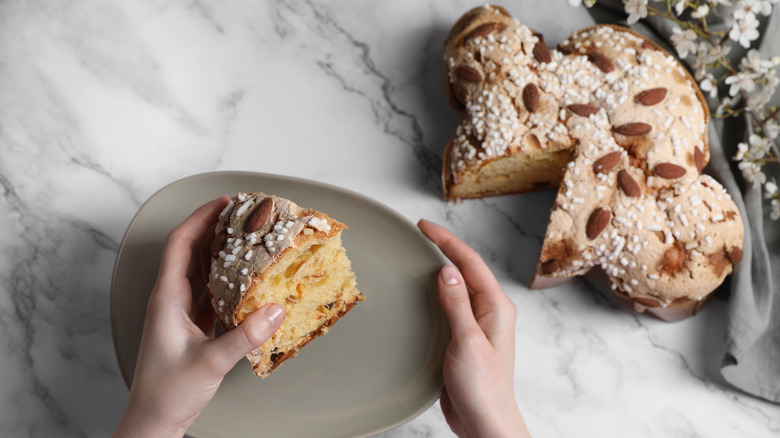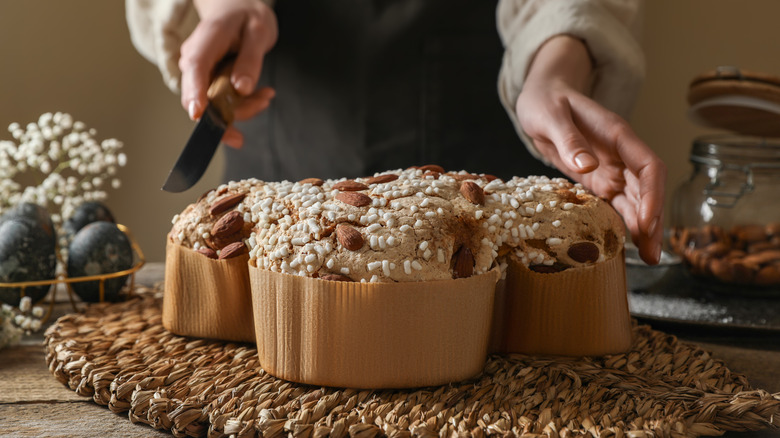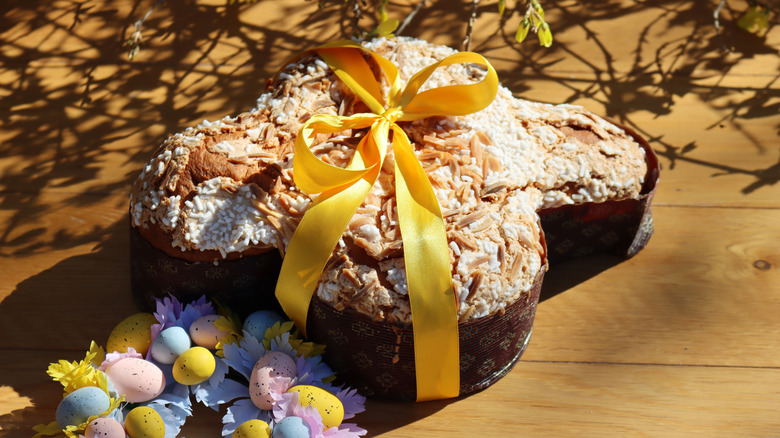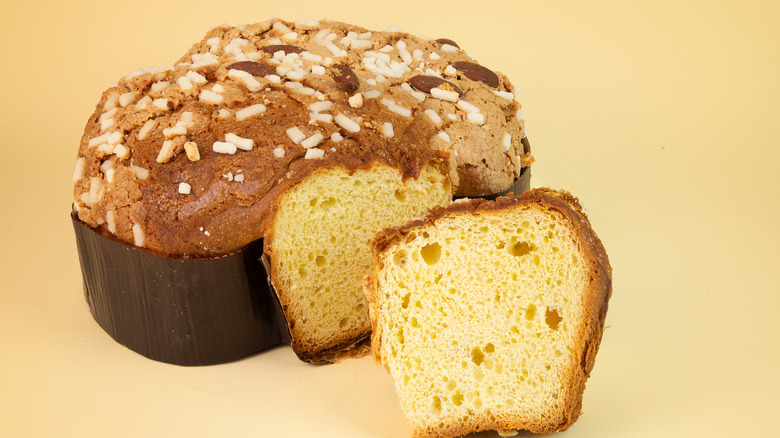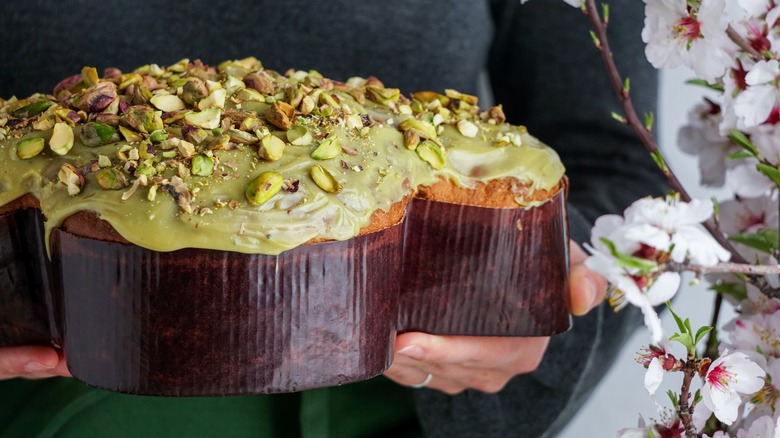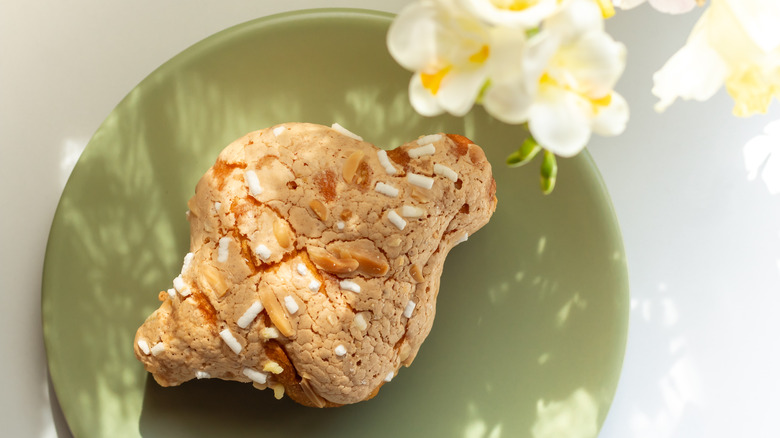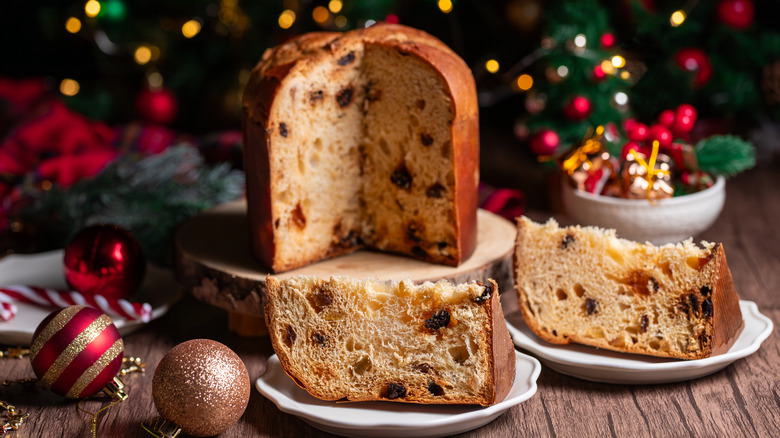What Is Colomba And Why Is It Eaten On Easter?
What I love about Italy is that every holiday is a big event and comes with great Italian food. At Christmastime, for instance, the stores are filled with panettone, a sweet bread full of candied fruit. Around carnevale — a pre-Lent blowout that lasts from one day to one month, depending on where you live — you can find deep-fried strips of dough covered in powdered sugar called chiacchiere, just about everywhere you look. Easter may be my favorite though, as Easter is the time of colomba.
Colomba may not be as popular in the United States as panettone, but it should be. This delightfully sweet Easter bread is a staple in Lombardy, where I live with my Italian husband. The name means "dove," which refers to the shape of the bread. In many ways, colomba is similar to panettone, but with a few noticeable, and very sweet, differences. Read on to find out what those differences are, and why the colomba has become such a big symbol of Easter.
What is colomba?
Colomba is a sweet, almost cake-like Italian bread. It's shaped like a dove; a symbol of peace that has long been associated with the Easter season. While it may come in many varieties, the classic version has pieces of candied orange peels inside and a sweet glaze on top, along with almonds and big, chunky, sugary sprinkles.
Making baked goods in the shape of birds to represent rebirth has been a thing since ancient Roman times, after which this pagan tradition eventually got folded into the Christian one. Some say that the colomba as we know it dates back to the 4th century, when San Colombano, the bishop of Milan at the time, brought a dove-shaped treat with him to a peace talk. Others, though, trace colomba's origins back to something a little more recent.
In the 1930s, a Milanese company called Motta was famous for its two Italian Christmas sweetbreads, panettone and pandoro. But Christmas only comes once a year, so the company wanted to come up with a product that would sell at other times of the year, too ... say, around Easter. So, using the same equipment and many of the same ingredients that went into Motta's panettone, the company created the colomba, which was "Eastery," thanks to its dove shape. The idea took flight, and now you can find a colomba on nearly every Italian table at Easter, right next to the chocolate eggs.
How is colomba made?
The basic ingredient list for colomba is simple: flour, eggs, butter, sugar, yeast, salt, water, and candied orange peel. To make a traditional colomba, you will also need whole almonds to put on the top, along with more sugar and egg whites for the topping.
But when it comes to the actual making of colomba, things aren't so simple. It's considered to be one of the more difficult Italian recipes. Many recipes involve creating a "biga," which is an overnight starter consisting of flour, water, and yeast. You combine these ahead of time so that the starter can activate before being added to the other dough ingredients the next day. The rising of the colomba dough is especially necessary to make it tall and fluffy — because it is naturally a very dense bread. The dough should even be left to rise at several other stages, too: after the dough has been kneaded for around 12 minutes, and the candied orange peels or other add-ins have been incorporated, and again after the dough has been placed in the mold, or has been separated into pieces to form the dove shape.
Next, the dough should be painted with the glaze, topped with the almonds, and baked for 15 minutes at 375 degrees Fahrenheit, and then for another 20 minutes at 350 degrees Fahrenheit (with the addition of a foil tent during the last 10 minutes). Then (finally) the Easter colomba is ready!
What does colomba taste like?
When asked to describe what colomba tastes like, the first word that comes to mind is "sweet." The large sprinkles and sugary glaze give it a crunchy exterior that brings a lot of sweetness to this bread, making it somewhat more like a cake. The interior, however, is less sweet and has a subtle fruity flavor. Colomba also has a dense, soft, and bready texture that contrasts well with the crunchiness of the glaze and the almonds on top. This makes it a hearty snack — and also one that's hard to stop yourself from eating.
Many people compare colomba to panettone, and while you can tell that they are made with the same buttery ingredients, I usually find that colomba has a lighter taste. Panettone usually has a butter wash over the top, which sometimes results in a slightly burnt flavor (at least, with the store-bought versions). But since colomba is made with a sugar glaze instead, it is sweeter and doesn't usually have this heavier, burnt-butter flavor.
How to eat colomba
Typically, colomba is cut into slices with a knife and eaten by hand (or, if you are my husband, torn off in big handfuls and eaten in chunks). Often, the treat is accompanied by coffee for a mid-morning snack or by a sweet digestif when enjoyed as a dessert. But this is just the tip of the iceberg.
Another favorite way to make this sweet treat even sweeter is to top it with ice cream. It takes colomba quite a while to get stale — plus, it's so tasty that it usually doesn't last long enough for it to dry out. But if it does, you can use leftover colomba to make parfaits or as the base for a tiramisu. You can also cut your colomba into slices like regular bread. If you do this, you can use it to make things like French toast. If you cut it into squares, you can use it to make a hearty pudding or a breakfast bake with eggs. So, while the colomba is terrific on its own, you have plenty of options if you want to mix it up and enjoy it in new and different ways.
Where to buy colomba
Colomba is pretty ubiquitous in Italy, appearing in huge supermarket displays as soon as the Easter season starts. In Italy, instead of asking, "Where can you buy a colomba?" you might be better off asking, "Where can you not buy a colomba?"
In the U.S., though, you may not have such an easy time finding this Easter bread. Colomba may be a bit more elusive there unless you know where to look. One place to start could be an Italian bakery, where you could surely find this traditional sweet, even in America. Or, if there are no bakeries near you — or if you prefer the convenience of online shopping — you can order a colomba from websites like Amazon or World Market.
Keep in mind, however, that colomba prices can vary greatly, no matter where you buy them. A more basic colomba from a well-known brand may cost $20 or less, but a more artisanal one may run from $60 to $100 or more.
Purchase Bauli La Colomba Classica on Amazon for $26.98.
Purchase Traditional Colomba from Ferrara Bakery for $20.95.
Purchase La Torinese Lemon Colomba Cake from World Market for $19.99.
Nutritional information about colomba
There are many varieties of colomba, and nutritional values may vary depending on the brand, and whether or not the product is homemade. But to give you a general idea of how eating a colomba may affect your diet, we will take a look at the nutrition facts for a classic, traditional, store-bought colomba.
A serving size of around 83 grams contains 330 calories. This portion includes 14 grams of total fat (18% of the recommended daily value for fat) and 8 grams of saturated fat (a whopping 40% of the daily value for saturated fat). Colomba is also high in cholesterol, with 100 milligrams (33% of your daily value per serving). So, a diet food this is not.
Taking a look at the total carbohydrate count, we have 45 grams per portion (16% of the recommended daily value). There are also 28 grams of sugar as well. A serving of colomba even includes 1.4 milligrams of iron and 40 milligrams of calcium, so at least there are a few vitamins and minerals!
The colomba, like most holiday treats, is meant to be an occasional snack. So, while you can enjoy it around Easter, it may be better not to eat tons of it every day, as it is not among the healthiest options out there.
Varieties of colomba
We have talked a lot about the classic colomba, but like with most festive baked goods, there are always other variations. Chocolate lovers, for instance, can find colombas made with chocolate chips, chocolate filling, and a chocolate glaze on top. Those who prefer nuts can find colombas with hazelnuts or pistachios (in addition to the standard almonds). Then, there are fruity colombas made with candied cherries or pears, as well as colombas made with a lemon or lime filling.
Chocolate and fruit variations are often easiest to find, but you can also find variations, like vegan colombas, that have a different recipe entirely. There are even different sizes to buy. While the normal (big) size is the most popular, there are also tiny, one-portion sizes to try as well. These make great Easter basket additions for children or a great snack for when you're looking to treat yourself.
How to store colomba
If properly preserved, store-bought colomba can last for a few weeks without getting stale. Simply keep it at room temperature, tightly closed within the plastic bag it came in. You can also store it in an air-tight box, but this may expose it to more air, so it is better to use plastic wrap if you don't have the original bag.
Homemade colomba tends to get stale faster, so it is recommended to only store it for a few days in plastic wrap or a plastic food storage bag. If you would like, you can also freeze some or all of your baked colomba for up to two months, but you should make sure that it has cooled to room temperature before putting it in the freezer.
Since this is a shelf-stable baked good like bread, there is no need to refrigerate either the store-bought or the homemade version of colomba. You can simply leave it on the counter, where it will be ready and available whenever you want to grab a quick bite!
Colomba vs panettone
Over the course of this article, we have done a lot of comparing panettone to colomba. While colomba was created by a company that produced panettone, with many of the same ingredients that go into panettone, there are some major differences between the two breads. First and foremost, panettone is shaped like an enormous muffin or a very tall, domed cake. Colomba, on the other hand, is shaped like a colomba, a dove.
The flavor of these two breads is also different. Panettone typically contains many different types of candied and dried fruits, but colomba only contains candied orange peel. A panettone has a dark brown exterior thanks to the layer of butter that's applied, but colomba has a sugary glaze, sprinkles, and almonds on top.
The most telling difference between the two breads may be that a panettone, along with pandoro, only shows up during the Christmas season, while colomba only flies into town for Easter. The two breads never cross paths ... unless you happen to have both of these long-lasting breads stored in your pantry at the same time, that is.
